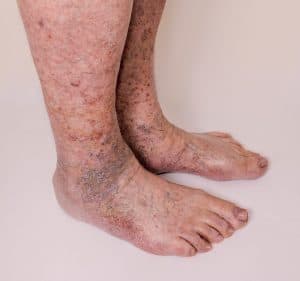
Microphlebectomy
Microphlebectomy, sometimes called an “ambulatory phlebectomy,” is a surgical procedure that can be used to remove some varicose veins. In most cases, a technique called endovenous laser ablation (ELVA) is used to remove varicose veins. However, in some cases, varicose veins are too twisty or close to the skin, to use ELVA. In these cases, a microphlebectomy is employed. First, the area is treated with local anesthesia. Next a needle is used to make a series of tiny punctures through the skin removing small parts of the dysfunctional vein. These treatments are an improvement over older methods of varicose vein removal including “vein stripping.” Microphlebectomy requires much less recovery time. Microphlebectomy: What to Expect
Microphlebectomy is performed in the office under local anesthetic so you avoid a busy and confusing experience in the hospital. You will be back at home in no time.
Microphlebectomy can be combined with endovenous laser ablation therapy to provide even better results.
Microphlebectomy: What to Expect
Upon entering the office, our staff will review your chart and confirm the details of your treatment. Recovery will be discussed and there will be time for you to ask any questions you might have.
The doctor will use a focused ultrasound exam to pinpoint the veins in the treatment site which are to be removed. To aid in the process, the veins may be marked on the skin using a marker.
Microphlebectomy is excellent at removing the dilated portions of the diseased veins. Microphlebectomy traditionally follows endovenous laser treatment (EVLA). An EVLA uses a laser to close the vein that feeds the varicose veins. Local anesthesia is administered to protect the patient from any possible discomfort. Next, a series of small holes are made with a needle along the route of the varicose veins. These punctures are used to access the troubling veins through the skin. A specialized tool is then used to hook the veins and remove them from the skin.
Once the procedure is completed, steri-strips are used to cover the access holes. No staples or sutures are required to close the puncture sites. Bandages are then placed over the steri-strips. Compression stockings are used to cover everything and help with healing. Before being discharged from the office, you will be asked to walk around to make sure there are no complications. Since only local anesthesia is used, you will be able to drive yourself home. You should return to the office the next day for a short follow-up appointment. The site will be examined and an ultrasound taken to insure positive results.
Can Elderly People Get Microphlebectomy? Is It Safe?
Yes, fortunately elderly people are allowed to undergo Microphlebectomy and it’s generally safe for them, especially if they are in good health. Thanks to the minimally invasive procedure, it’s performed under a local anesthesia which reduces the risks that come with surgeries. However, elderly must go through a medical evaluation before the procedure to make sure they are completely ready for Microphlebectomy and won’t suffer from any problems later on.
Does Microphlebectomy Improve Symptoms Like Pain and Swelling in Legs?
Yes, Microphlebectomy improves symptoms like pain and swelling, as this treatment completely removes the varicose veins, the main cause of swelling and pain In your body. Once they are removed, you will experience improved blood flow, reduced pressure and discomfort in the affected area, and ease from pain.
There Are Any Alternatives To Microphlebectomy?
Yes, there are multiple alternatives of Microphlebectomy to treat varicose veins, here are some of them:
- Sclerotherapy: It’s a procedure where a solution is injected in your veins, which causes them to close, collapse and eventually fade away.
- Endevenous Laseer Therapy (EVLT) : A laser therapy that useses laser energy to seal of varicose veins from the insides.
- Compression stockings: Compressions stockings that reduce swelling, and help improving blood flow, which reduces varicose veins symptoms.
- Lifestyle changes: Quitting smoking, alcohol, decreasing some weight, regular low impact exercises that improve blood circulation are some good home remedies especially if your varicose veins are new.
Will I Have Scars After Microphlebectomy? Will They Be Visible?
Unfortunately, yes you will have scarring as Microphlebectomy leaves very minimal scarring, as the incisions are small, usually around 2-3 millimeters. Fortunately, overtime these thiny scars fade aaway and become barely noticeable. However, also remember the visibility of scars depend on the healing process of the patients and the skin tone can play a role too.
Is It Good For You?
Microphlebectomy can be the best option for you if the majority of your varicose veins are on the skin’s surface. Following a reasonably quick procedure called a microphlebectomy, you’ll be able to resume your regular activities. You might even be able to prevent developing further varicose veins in the future with proper care and lifestyle modifications.

